Tūhono
About Māori land in New Zealand
Whenua Māori is our tūrangawaewae – it's part of who we are. We need to understand and acknowledge the history of our whenua so we can move forward into the future as kaitiaki.

History of Māori land
Find out about key events throughout history that have shaped the current state of Māori land.

What is Māori land?
There are different types of Māori land – Māori freehold land is the most common, though it makes up only about 5% of Aotearoa now.

Why whenua matters
Our whenua is our tūrangawaewae, our place to stand. It connects us to our whānau, our ancestors and to our future generations.

How Māori land ownership works today
Ownership of Māori land is complex — there are often many people involved, and strict rules and processes around how it can change hands.